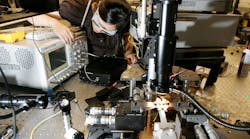What motivated MCFA to develop this product?
Jungheinrich is constantly looking to take advantage of evolving and progressing technology, and how that technology can be translated into product improvements across the line-up. The ETV/M 2 Series development was motivated by a desire to improve energy efficiency and broaden the range from the previous generation of trucks. MCFA is excited to introduce this new Jungheinrich reach truck to the North American market.
How is this product different from similar reach trucks on the market today?
The ETV/M 2 Series offers exceptional performance and efficiency characteristics, unmatched by other truck types and models. In addition, the ETV model is a sit-down truck with automotive-style controls, which makes it very comfortable for operators—especially when they are operating the truck in long shifts. Reach trucks are widely used in cold storage facilities where the operators will have to exit the freezer or cooler periodically to warm up. What makes this truck unique is the ability to fit it with a freezer cabin that will allow operators and the truck to stay inside coolers and freezers throughout the shift for increased productivity. The extra minutes and hours each shift that an operator can spend on productive work rather than downtime add up to significant savings.
What problems needed to be addressed during the development process?
Reach trucks are used across a wide range of applications and handle a wide variety of products, so there isn’t a “one sizes fits all” approach that help guide the development process. The challenge for the Jungheinrich engineers was to redesign the ETV/M 2 Series to broaden the range and fit customer applications ranging from light to heavy-duty. The solution was to deliver a range of trucks that could be offered in a base configuration for the average user, but optioned up with premium features to handle the most demanding, high-cycle applications.
What effect did cost factors have in changing the final design of the product?
Cost is always a critical factor, and was addressed from a customer perspective. First, by offering users the option of a base model with option packages, Jungheinrich was able to offer a quality truck to the market matched exactly to the user’s needs—without a lot of add-ons or extras. For customers with more sophisticated needs, options can be added to configure the truck precisely to the application needs. Second, the inclusion of next-generation technology allows the truck to lower energy costs and run longer on the same battery.
Who is your target audience and what benefits will they achieve from using this product?
While the ETV/M 2 Series appeals to a broad range of industries and users, it really hits the mark in high-throughput applications. With its performance and efficiency characteristics, it will boost productivity and has a high potential to save energy cost for customers. The availability of a cold storage cabin makes it the perfect alternative for freezers and coolers. And for the operator, the sit-down design and automotive controls make this truck a great alternative to the traditional stand-up designs that make up a majority of the market—especially over an 8-hour shift.










